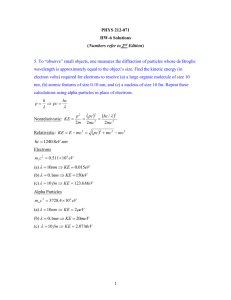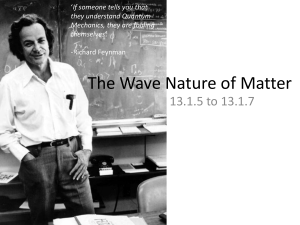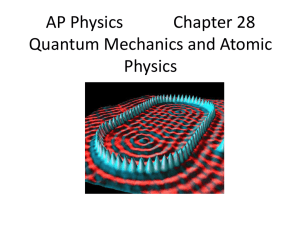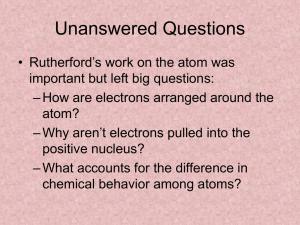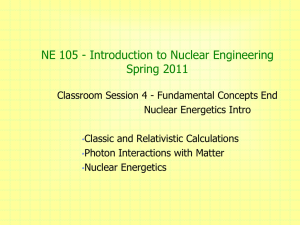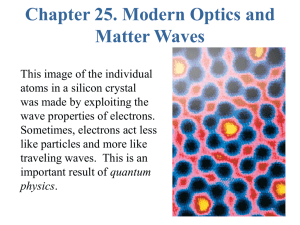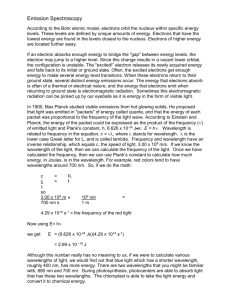Electrons measure the size of nuclei
advertisement
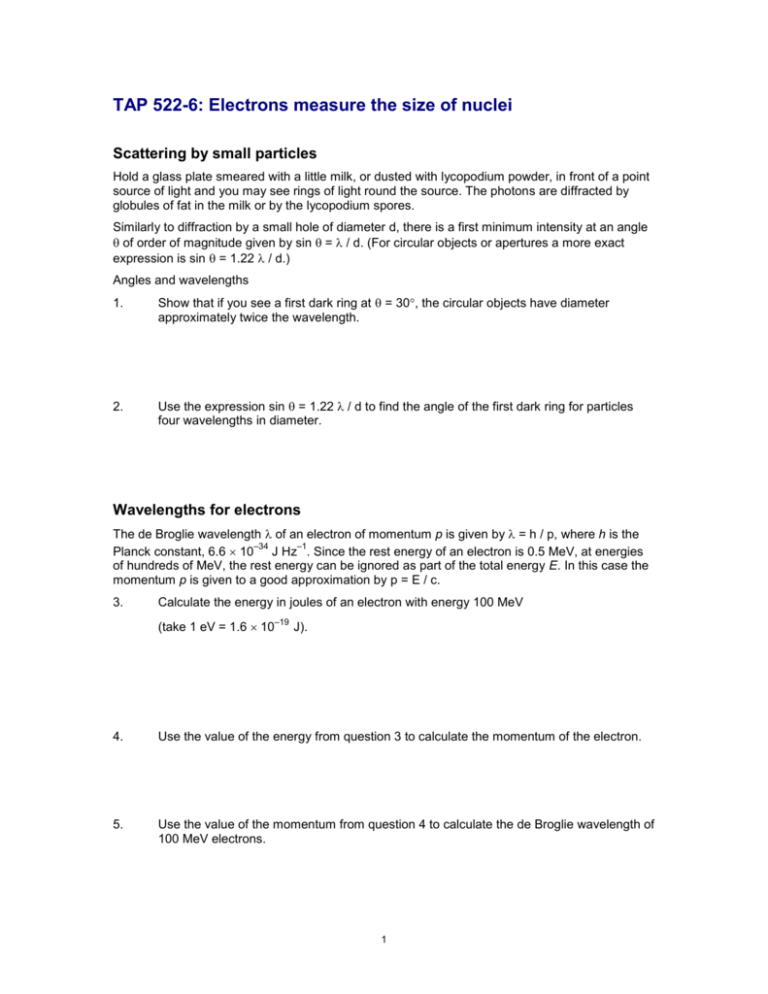
TAP 522-6: Electrons measure the size of nuclei Scattering by small particles Hold a glass plate smeared with a little milk, or dusted with lycopodium powder, in front of a point source of light and you may see rings of light round the source. The photons are diffracted by globules of fat in the milk or by the lycopodium spores. Similarly to diffraction by a small hole of diameter d, there is a first minimum intensity at an angle of order of magnitude given by sin = / d. (For circular objects or apertures a more exact expression is sin = 1.22 / d.) Angles and wavelengths 1. Show that if you see a first dark ring at = 30, the circular objects have diameter approximately twice the wavelength. 2. Use the expression sin = 1.22 / d to find the angle of the first dark ring for particles four wavelengths in diameter. Wavelengths for electrons The de Broglie wavelength of an electron of momentum p is given by = h / p, where h is the –34 –1 Planck constant, 6.6 10 J Hz . Since the rest energy of an electron is 0.5 MeV, at energies of hundreds of MeV, the rest energy can be ignored as part of the total energy E. In this case the momentum p is given to a good approximation by p = E / c. 3. Calculate the energy in joules of an electron with energy 100 MeV (take 1 eV = 1.6 10 –19 J). 4. Use the value of the energy from question 3 to calculate the momentum of the electron. 5. Use the value of the momentum from question 4 to calculate the de Broglie wavelength of 100 MeV electrons. 1 –15 6. The radius of a single proton or neutron is of the order 1.2 10 m. What approximately is the ratio of the wavelength of the electrons to the diameter of a proton or neutron? 7. Using the relations p = E / c and = h / p show that the de Broglie wavelength is inversely proportional to the energy E. 8. Use the result of question 7 and the answer to question 5 to show that the de Broglie –15 wavelength for 400 MeV electrons is about 3.0 10 m. Electron scattering by nuclei You have seen that electrons of a few hundred MeV have de Broglie wavelengths comparable to the diameter of a nucleus. Suppose that in an experiment a beam of 400 MeV electrons is scattered by carbon-12 nuclei. The angle at which the scattering is first a minimum is 42, for which sin = 0.67. 9. Calculate the ratio / d of the de Broglie wavelength to the diameter of a carbon-12 nucleus. 10. Use the de Broglie wavelength of 400 MeV electrons from question 8 to show that the –15 radius of a carbon-12 nucleus is about 2.7 10 m. 11. You might expect the volume occupied by the 12 nucleons of carbon-12 to be 12 times –15 the volume occupied by one nucleon. The radius of a nucleon is about 1.2 10 m. Show that the ratio of the volumes is about 12 (expect some rounding error in these figures). 2 12. –15 A uranium-238 nucleus has a radius of about 7.4 10 m. What roughly would be a good energy of electrons to use to determine its radius by scattering? Hints 1. sin 30° = ½. 2. Substitute in the expression for sin q. 3. The conversion factor is equal to the magnitude of the charge on the electron. 4. Use p = E/c. 5. Use λ = h/p. 6. Remember that the diameter = 2 x radius. 7. Substitute p = E/c for p. 8. Scale down the wavelength in proportion to the increase in energy. 9. Obtain the ratio λ/d from the value of sin q. 10. Remember the radius is half the diameter. 11. The ratio of the volumes is the cube of the ratio of the radii. 12. Choose a reasonable angle, say 30°. 3 Practical advice These questions lead students through a numerical example of the measurement of nuclear dimensions by electron scattering, using the diffraction of the electrons to obtain the scale. Many students will require help with the powers of ten involved, and the conversion between electron volts and energy in joules. The questions are intended primarily as ‘learning questions’ to be gone through slowly. Some students may profit from tackling them alone, but most will need to be taken through them, and have the general message pointed out for them. Social and human context To measure these tiny distances needed a linear accelerator a few kilometres in length. Large energies to measure small dimensions are expensive. Answers and worked solutions 1. sin 30° = ½ = λ/d approximately. 2. sin 1.22 d 1.22 4 0.305 . The angle whose sin is 0.305 is 17.8°. 3. Energy 100 MeV 10 8 eV 10 8 eV (1.6 10 19 J eV 1 ) 1.6 10 11 J. 4. p E c 1.6 10 11 J 3.0 10 8 m s 1 0.53 10 19 kg m s 1. 4 5. h p 6.6 10 34 J s 0.53 10 19 J m 1 s 12 10 15 m. 6. Ratio of wavelength to radius = 12 x 10–15 m / 1.2 x 10–15 m = 10; ratio of wavelength to diameter = 5. 7. Substitute p E c in h p gives 8. hc . E From hc E λ is inversely proportional to E. Since λ for 100 MeV is 12 x 10–15 m then λ for 400 MeV is 3 x 10–15 m. 9. Since sin = 0.67, then 0.67 = 1.22 λ / d, and λ / d = 0.55. 10. Since λ for 400 MeV is 3 x 10–15 m, and λ / d = 0.55, then d = 5.5 x 10–15 m and r = 2.7 x 10–15 m. 11. (2.7/1.2)3 = 11.4. It would be closer to 12 but for rounding errors. 12. Diameter of the uranium-238 nucleus = 15 x 10–15 m. Choosing λ λ = 30 x 10–15 m, about five times the wavelength of 400 MeV electrons (3 x 10 –15 m). So scale down energy by a factor 5, to say 80 MeV. 5 External reference This activity is taken from Advancing Physics chapter 17, 90S 6
